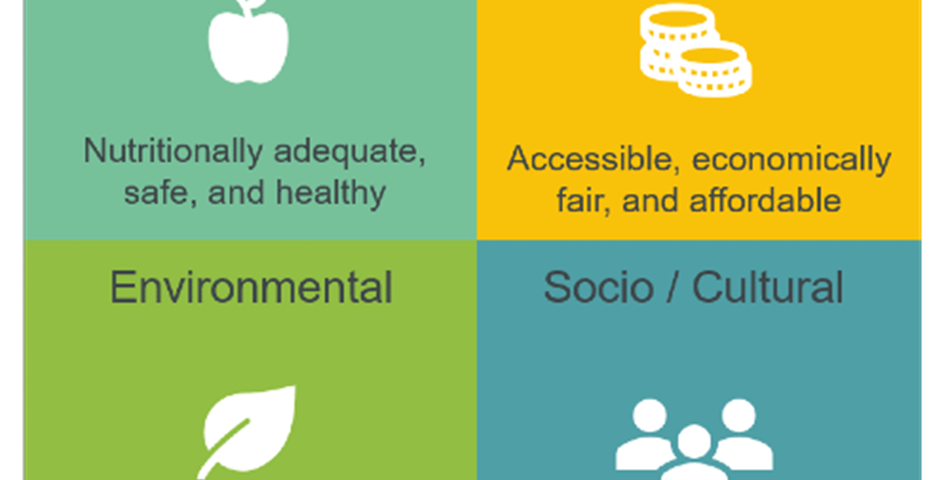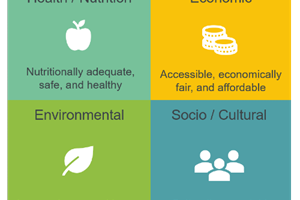Sustainable Nutrition refers to the ability of food systems to provide sufficient energy and essential nutrients to maintain good health of the population without compromising the ability of future generations to meet their nutritional needs.
Dimensions of sustainable nutrition
- Health & nutrition
- Environmental
- Economic
- Socio-cultural
To ensure the health of people, the planet, and society, it is important to think additively about these four factors.
Around 30% of the food we produce globally every day is wasted (FAO 2019), yet there is still much of the world that is undernourished.
Through the lens of sustainable nutrition, we have to be mindful of questions like:
- Is the nutrition tailored for the people for which it is intended? Are they overnourished or undernourished?
- Is the food safe?
- How was the food produced? How did that production impact the environment, and could there be a better choice?
- Is a healthy food realistic for this person to obtain? Can they access it and afford it?
- Is food appropriate for the target community’s dietary behavior, religious beliefs, or local food system?
Health & nutrition
The first aspect of sustainable nutrition is getting the right food and nutrients to the right people. It includes the healthfulness or nutrition quality of foods, as well as food safety. This means reducing intakes of nutrients linked to disease (e.g. sugar, sodium) while increasing nutrients that are beneficial for health (fiber, protein, vitamins, minerals, etc).
Globally, there are 2 billion people who are currently overweight or obese while, at the same time, there are 690 million people who go hungry or are malnourished every day. These two groups of people have very different nutrition needs. It is important to consider for whom a nutrition solution is intended and tailor it to that individual or group. In countries where most of the population is overnourished, many regulations and initiatives will focus on calorie, sodium, and sugar reduction. Programs targeting areas where a large proportion of people are undernourished, there is more of an emphasize on delivering calories, protein, and essential vitamins and minerals to prevent disease (e.g. vitamin A, iron).
Environmental
Measurements of the environmental impact of food systems typically include greenhouse gas (GHG) emissions, water use, and land use, but can also include factors like biodiversity, pollution, etc. Food waste is a prime target of many initiatives because ~30% of food produced globally is wasted every day. Food systems account for up to 35% of global GHG emissions, occupy ~40 percent of Earth’s land area, and is the largest driver of biodiversity loss (FAO WHO report on sustainable diets).
Economic
The economic impacts of Sustainable Nutrition and Sustainable Healthy Diets could be the most wide-reaching because they can be felt by all, to some degree.
For those experiencing malnutrition, the economic pressure facing them may be that they cannot afford safe, healthy food and are subsequently forced into either food deprivation or are only able to afford cheaper, less nutritious foods.
One example of this is the concept of food deserts, which are regions of a country in which individuals do not have the option of purchasing nutritious food due to limited income and/or means of transportation. If the closest supermarket that sells fresh produce is 30 km away from where someone lives, but they do not have a car or means of realistically reaching that supermarket, then that food is not available to them. In these situations, families will often end up buying groceries from a local gas station or other market with limited supply of healthy foods. These regions are common in developed countries where food is abundant for most of the population.
Socio-cultural
Another layer to consider when forming a system that supports sustainable nutrition is diets that are appropriate for different socio-cultural beliefs and backgrounds. Just as there are numerous diverse cultures around the globe, so too are there diverse cultural elements to nutrition.
A nutritious diet in one part of the world may not be appropriate for another. For example, meat is rich in many essential minerals like iron or zinc. Despite some cultures lacking these nutrients in their diet, meat may not be acceptable to their social or religious beliefs. As a result, finding culturally appropriate sources of those nutrients is essential.
Ensuring access to healthy, sustainable, and culturally acceptable foods are all vital elements in transforming the way our society lives and eats. Considering factors such as socio-cultural values and standards will help a sustainably nutritious food system succeed.










